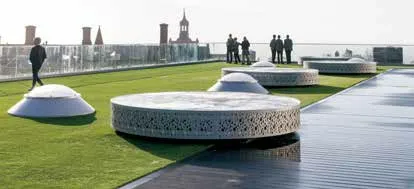布莱顿学院 英国布莱顿
项目状况:2020 年元月竣工
业主单位:布莱顿学院
主管合伙人 :埃伦·范·伦
项目总监:Carol Patterson
结构工程 :Fluid Engineering
景观设计 :Bradley-Hole Schoenaich
照明设计:Les Eclaireurs 与 Ducks Scéno
承建商:McLaren
总建筑面积:7 425 平方米
摄影:Killian O’Sullivan,Laurian Ghinitoiu,Liz Finlayson/Vervate
Status:Completion January 2020
Client:Brighton College
OMA Partner:Ellen van Loon
Project Director:Carol Patterson
Structural Engineering:Fluid Engineering
Landscape:Bradley-Hole Schoenaich
Contractor:McLaren
Lighting Design:Les Eclaireurs with Ducks Scéno GFA:7 425 m2
Photography:Killian O’Sullivan,Laurian Ghinitoiu,Liz Finlayson/Vervate


布莱顿学院科学与体育系的设计打破了教育建筑的传统特征,摒弃了没有尽头的走廊和刻意营造的寂静,而是将两个学院结合在一起,创造了一座充满活力的建筑,为学生们提供了自由的活动机会。考虑到学习的过程在教室内外均有发生,该设计引入了新的教育理念,创造出促进互动和交流的教学空间。
这样的话,那为什么要将科学系与体育系分开?恰恰相反,两栋建筑物互为融合,形成有机线性体,坐落于运动场的边缘,独具特色。主要的运动空间与球场齐平,直接面向运动操场。科学楼包含教室、图书馆和一个温室,在运动场地展开,形状犹如一个摇摆桥,可谓造型独特。立面的部分灵感来自新建筑对面的连栋房屋。站在屋顶可以一览无余的俯瞰北海。
该建筑的设计理念核心就是要加强学生之间的互动与交流。开阔无局限的室外环境打破了空间的限制,为学生的日常交流和学习再一次扩容。层级转换、超大台阶与玻璃设计让各式各样的活动可以在两个系之间自由进行,让不同专业学生的互动交流提升到新的高度。建筑物的每个组成部分既互为独立,又紧密联系,已形成一个有机整体。该建筑的设计独具慧眼,从高处可清晰看到第一层的室内跑道,教室可通往天花板窗户,甚至化学教室的通风柜也呈现透明状态,学生在路过闲谈中即可看到实验过程,实是妙不可言。
OMA在2013年举办的比赛中拿下了该项目。彼时布莱顿学院决定扩建科学院,增加实验室,并希望增设一流的运动设施,以期更好促进学生身心和才能的发展。起初,在如何设计体育系和科学系的竞选中,两个系的设计互为独立,并非为一个整体。在2013年方案修订后,经历了2014年的二轮竞选,设计方案于2015年被批准,并于2017年动工。项目建设的总预算为3670万英镑。
布莱顿学院于1845年建校,经过多年的发展,作为一所私立、男女混合全寄宿学校,名声日渐显赫,现已成为英国顶尖名校之一。该校校园分为两部分:一个是历史悠久的四合院,该四合院包含19世纪由吉尔伯特·斯科特先生和托马斯·杰克逊设计的二年级教学楼;一个是与20世纪70年代到80年代建筑物并列的运动场,是新建筑所在地。
The School of Science and Sports at Brighton College defies the conventional character of educational buildings– one of endless empty hallways and imposed silence– and instead combines the two departments to create a vibrant building with lively spaces where activities are not necessarily dictated by a school timetable.Observing that processes of learning take place outside as much as inside of the classroom,the design articulates a new idea of educational space bolstering interaction and exchange.
Why isolate the department of Science from the department of Sports? Instead,the two are merged into one linear volume,situated at the edge of the playing field.Primary sporting spaces are on level with the field,and the sports hall opens directly onto it.The Science department,which include classrooms,laboratories and a green house,spans over the sporting spaces like a skeletal bridge.The façades are inspired in part by the regular rhythm of the terraced housing opposite the new building.The rooftop provides a sweeping view of the North Sea.
Stimulating social communications between the students was central in the concept:generous and open break-out space outside of the classrooms create room for informal interaction and private studying.Level shifts,grand staircases and glass visually connect the activities taking place in both departments and trigger unexpected exchanges between different disciplines.Individual components of the building are exposed to each other:an indoor running track on the ground floor is visible from upper levels,classrooms have floor to ceiling windows,even fume hoods in the chemistry classrooms are made transparent– enabling people walking down the hallway to witness ongoing experiments.
OMA was awarded the project after a competition organized in 2013,when Brighton College needed to expand the Science School in terms of number of labs,and wanted a state-of-the-art sporting facility to foster talent and physical wellbeing.In the original competition brief the Sports Center and Science Department were presented as two separate projects.After a revised brief in 2013,and a second competition phase in 2014,planning approval was acquired in 2015 and construction started in 2017.The project was realized with a total construction budget of £36,700,000.
Established in 1845,Brighton College is a private,co-ed boarding and day school in Brighton,England,and over the years has cemented its reputation as one of Britain's leading schools.The campus is comprised of two areas:a historical quadrangle,composed of Grade II listed buildings designed by Sir Gilbert Scott and Sir Thomas Jackson in the 19th century;and the playing field lined with buildings from the 1970s and 1980s,the site of the new building.













——庆祝湖南农业大学草业科学系建系20 周年

